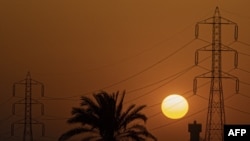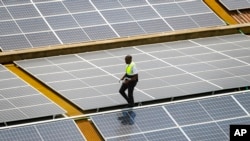The Climate Overshoot Commission said research and experiments into so-called solar radiation modification (SRM) should move forward, but only under international supervision and in jurisdictions with strong environmental safeguards.
Currently, there is no formal global governance for the development or deployment of such technologies, and an incomplete understanding of the risks they carry.
"We need a moratorium," commission member Laurence Tubiana, head of the European Climate Foundation and an architect of the Paris Agreement, told AFP.
"We know the risks — this is not a silver bullet solution."
The failure to reduce the greenhouse gas emissions that drive global heating has led to suggestions that solar geoengineering — widely dismissed a decade ago as unnecessarily risky — could buy time while the world scales up emissions reductions and CO2 removal.
Barely 1.2 degrees Celsius of warming so far has boosted the intensity, frequency and duration of deadly and destructive heatwaves, droughts and megastorms.
The 2015 Paris climate treaty calls for capping the rise in Earth's surface temperature to 1.5C above mid-19th century levels to avoid catastrophic impacts.
The commission takes its name from the strong likelihood that warming will breach, or "overshoot," that target, probably within a decade, according to the U.N.'s Intergovernmental Panel on Climate Change, IPCC.
In 2018, the IPCC concluded that greenhouse gas emissions must drop 43% by 2030 in order to cap global warming at the 1.5C threshold.
"As we approach the midpoint to that deadline, emissions have not decreased, but rather increased," former World Trade Organization head Pascal Lamy, who chaired the commission, said in its report.
"The need for action is clear and immediate."
'Termination shock'
The commission — 13 former leaders and ministers from Pakistan, Canada, Niger, Indonesia and the Pacific Island nation of Kiribati, along with top academics and foundation heads — was formed to propose novel strategies to mitigate the risks of overshooting the Paris agreement target.
Slashing emissions of CO2, methane and other planet-warming gases remains the top priority, it said.
In line with findings and policy objectives from the IPCC and the International Energy Agency, IEA, their report also called for boosting technologies for syphoning off CO2 from industry and power generation, and to removing it directly from the atmosphere.
But the commission's most anticipated conclusions were on SRM.
Solar radiation modification methods include brightening marine clouds by seeding them with salt particles from the ocean, and placing giant mirrors in space to reflect away Earth-bound sunlight.
But the technique thought to have the highest potential is injecting aerosols — especially sulphur particles — into the stratosphere to reflect sunlight back into space.
Nature sometimes does the same: the violent 1991 eruption of Mount Pinatubo in the Philippines — which spewed millions of tonnes of dust and debris — lowered global temperatures for about a year, especially in the Northern Hemisphere.
But there is growing evidence that the advantages of cooling Earth's surface must be weighed against unwanted side effects.
Artificially dimming the Sun's radiative force is likely to disrupt monsoon rains in South Asia and western Africa and could ravage the rain-fed crops upon which hundreds of millions depend for nourishment, several studies have shown.
It could also reverse progress in the recovery of the ozone layer that shields life on Earth from deadly ultraviolent radiation, according to the Scientific Assessment of Ozone Depletion report earlier this year.
Scientists likewise warn that Earth's surface would heat rapidly if seeding the atmosphere with Sun-blocking particles were to suddenly stop, known as "termination shock."
With few exception— such as Mexico, which has banned solar geo-engineering experiments — most governments have yet to put regulations in place governing SRM.



Forum